The CBC has published a study produced by Lichfields on the back of Michael Gove’s announcement yesterday
You can read the press release here and scroll down to the link to the report. This follows Michael Gove’s statement to Parliament on 08 April 2024 which I wrote about here.
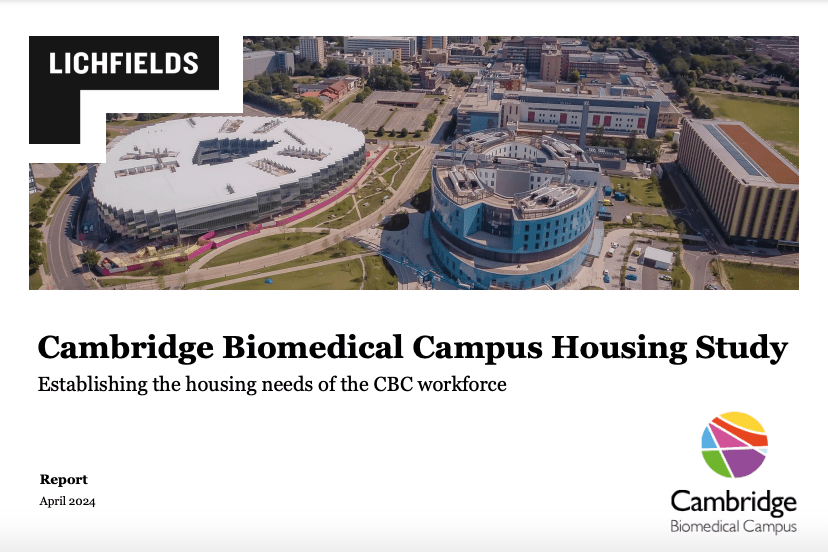
And their headline findings are…


The Cambridge Biomedical Campus will require the building of a settlement larger than Haverhill just to have its own needs met
That’s not including the boom in the science park sector that already includes:
- The Beehive Centre
- The Grafton Centre
- Capital Park, Fulbourn
- Mission Street (Coldham’s Lane west of Cherry Hinton)
- Sawston’s huge sci tech park
This means the Greater Cambridge Partnership should give up on their flawed busway proposals south east of Cambridge (CSET) – the scale of the Government’s ambition has grown beyond. I agree with what Cambridge Connect have stated below.

Above – the Cambridge Connect proposals (Late 2023 iteration)
“What does the existing and emerging local plan say?”
In one sense Michael Gove says it doesn’t matter because his proposals for a development corporation allow for this to be outside the local planning process. Whether Labour follow through with this remains to be seen.
“Current evidence in the emerging Greater Cambridge Local Plan identifies a need for a further 14,500 homes between 2020 and 2041, in addition to the 37,200 homes already provided for by the 2018 Plans, reflecting jobs forecast for the area.”
Greater Cambridge Shared Planning Service, 05 March 2024
Note that’s for Cambridge *and* South Cambridgeshire, the existing local plan (2018-30) being the 37,200 figure. Yet the construction industry is unable to build out the planning permissions it already has – citing labour/skills shortages and a spike in construction and materials costs.
Which is a symptom of the onmishambles of a government that has utterly failed to provide the training and retraining opportunities needed to ensure more locally-based people can reskill and re-equip to fill those much-needed skills gaps. The system of online learning and endless loans simply have not worked. Furthermore, the ideological blinkers that date back to the 1980s are ones that ministers refuse to remove: ones that prevent them from enabling local councils to build directly like in the olden days. Because ***oooh! Soshlism!!!*** The result? This.

Above – from BBC News 21 Nov 2019
This reminds me of the point that author Jon Alexander (of Citizens) made earlier at Together Culture when he said that we had lost the ability to imagine radical political solutions to our chronic problems. You can see the huge collapse in council house building in the early 1980s before John Major’s government finally killed it off. Only a handful of councils have won the right and the funding (such as Cambridge City Council) to build a new generation of council housing – in return for relinquishing powers and agreeing to support things like the Combined Authority. A smart move by former councillors Herbert and Price for digging in on that.
“How could this possibly go catastrophically wrong, and who is doing what to prevent it?”
What does failure look like? Brookgate/Marque-style minimalist monoliths meeting the bare minimum legal requirements, sold to international corporations and speculators which can then use oligopoly power to maintain artificially-high rents to extract even more wealth out of Cambridge as the workforce sees a disproportionate amount of its income going on rent. Sort of like what every other bright-eyed twenty-something graduate faces when they go into the corporate world in London. (I was like that once).
Suffolk, Cambridgeshire needs to have a conversation with you
Only the Cambridge Biomedical Campus has its eyes on some of your villages and towns.
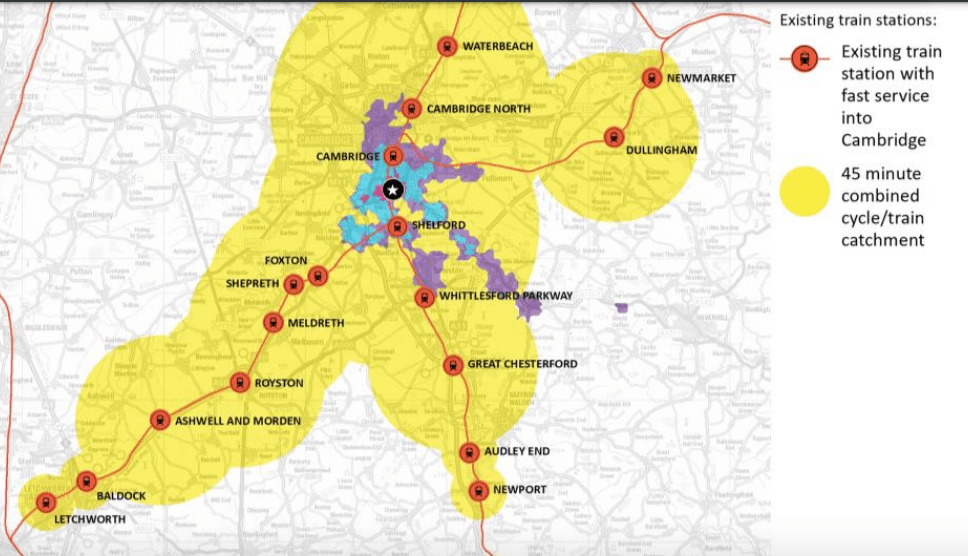
Above – CBC (2024) p26
You’ll see Dullingham highlighted top right just before Newmarket. Given that *some level of growth* is inevitable (even in a transition to whatever the climate emergency makes us transition to), my take follows what others have said: upgrade existing transport corridors and build new housing around existing stations – see second half of this post.
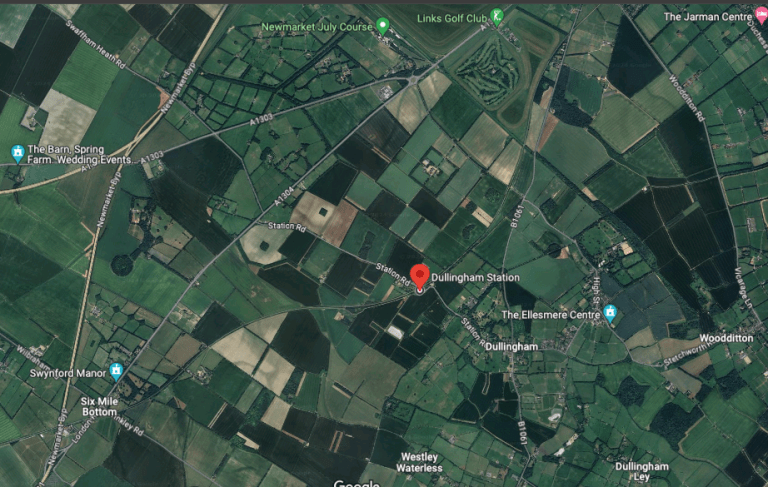
Above – Dullingham station is an ideal location in principle.
If you are a minister of the Crown looking for a site with minimum pre-existing population close to a major dual carriageway and on a railway line. Not surprisingly, land speculators and developers have already carved out options and are lobbying heavily to get the agricultural land redesignated for housing. The problem for decades has been that ministers have chosen not to impose a land value uplift levy, which means the fortunes to be made from land speculation are huge – ones that extract financial value from the site that really should be paying for community amenities and transport infrastructure upgrades.
You can also see on p27 below that the Greater Cambridge Partnership’s long-delayed plans feel feeble compared with the continued growing ambitions of ministers and the sci-tech sector. Note Kennett is also identified with Dullingham within the 45 minute commuting zone.

Above – CBC (2024) p27

Above – Kennett in Suffolk – a railway station with lots of open land
I included the above in a blogpost asking if ministers had learnt the lessons of previous generations of newtown development. Note that Rail Future East have been campaigning for years to get the track upgraded anyway – if only to facilitate improved services and reduced road traffic.

Above – from Rail Future East and the proposed Cambridge East railway station somewhere between Cherry Hinton and Fulbourn.
The Cambridge Biomedical Campus needs to remember that its workers are human beings. Not simply just the supply of labour of economics textbooks.
I say that as someone with an economics degree – albeit from over 20 years ago.
The first thing to look at is what the CBC considers as its ‘catchment’
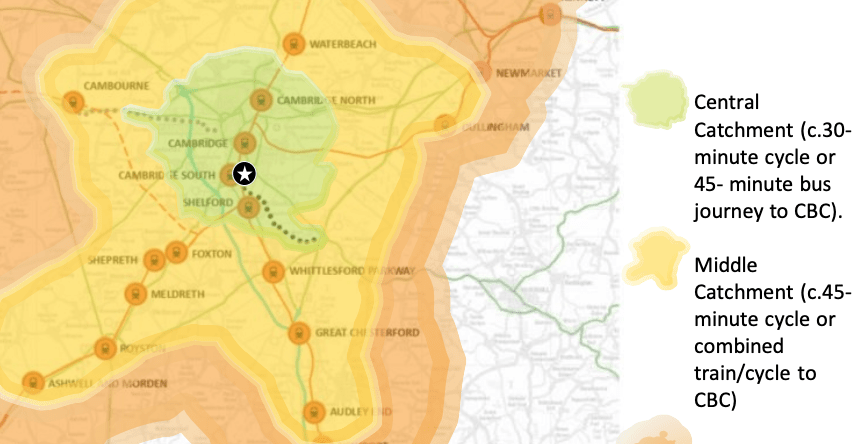
Above – CBC (2024) p53
Note the list of ‘shoulds’ from the CBC on the following page, including the following on the central catchment
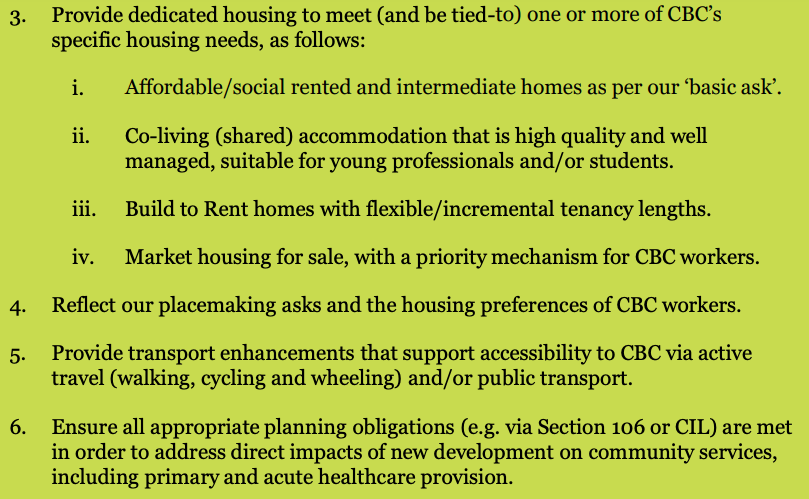
Above – CBC (2024) p54
Number 4 is particularly interesting. Not least because:
- No mention is made of the families of CBC workers who may have their own preferences.
- The list is written (irrespective of merit or otherwise) as if the CBC is the monopoly employer for the whole of the city and catchment area. Which clearly is unacceptable.
Furthermore, what Lichfields says is social infrastructure does not match what others say social infrastructure is.

Above – CBC (2024) p24
What the consultants have listed as social infrastructure are in fact buildings that in the main have public services provided from them. The problem is the Government has made such a mess of GP and dentistry provision that no one can get an NHS dentist within 30 miles of Cambridge. Here’s Healthwatch Cambs & Pboro – the statutory watchdog on health and social care provision for our patch this time last year (May 2023). Where are these new dentists going to come from?
Coming back to social infrastructure:
“It would be easy to assume that social infrastructure must be publicly provided, and indeed publicly funded libraries, community centres and parks are often key examples of social infrastructure within communities. However, for many people, a local pub or shopping centre may represent a more integral pillar of daily social interaction that contributes towards feelings of belonging.”
Above – from the British Academy, Lilian Barrett (2023)
This came up at Together Culture earlier as well – people seeing this new start up as part of the social infrastructure of The Kite in Cambridge. One of the things they (we!) are looking into is the historical past of the neighbourhood in order to shape the culture of today and tomorrow.
Contrast that with this report by Lichfields which, as with Gove’s Case for Cambridge report reads like it was produced by people unfamiliar with the city and surrounding district.
Not surprisingly, Lichfields don’t actually have an office in Cambridge. You can read their blogposts that crop up in a keyword search for Cambridge here. That’s not to say having an office in Cambridge will make any difference. Culture and values matter. At present I’m not seeing much in this report that appears to learn from our local history or one that shows any meaningful involvement with local communities not just within Cambridge but in the surrounding towns and villages – including over the county boundary.
“Is it all bad news for the Cambridge Biomedical Campus?”
It doesn’t have to be. For a start several of us met two of their representatives at the AGM of the Queen Edith’s Community Forum in Feb 2024. I filmed their talk below.
Above – Simon Day and Gill Wilson of CBC to QEQF, 22 Feb 2024. Filmed by Antony Carpen (Me!)
The things I think that the CBC should look to do include:
- Engage meaningfully with existing neighbouring communities – in particular what their ‘placemaking asks’ are. Don’t just think a small community room and a couple of yoga classes and a cafe serving lattes (much as I like drinking them) will do the trick because as Dr Andy Williams (who you are familiar with) told us, you have to fill an existing infrastructure gap created by the failures of previous ministers.
- Be flexible and be clear and upfront on what you are willing to be flexible about – don’t just tell us what your list of ‘requirements are.
- Accountability, responsibility, and good governance matter – be excellent citizens and push back against national government on the major failings and shortcomings of their proposals, such as the failure to even mention the broken system of local government in and around Cambridge (something identified as a national problem by the Commons Public Administration and Constitutional Affairs Committee on Oct 2022).
As for the existing residential communities around the CBC, we are going to have to run community events to come back with collective responses to this report. There’s too much in there for one person or even one neighbourhood/community forum in here to cope with alone.
Food for thought?
If you are interested in the longer term future of Cambridge, and on what happens at the local democracy meetings where decisions are made, feel free to:
- Follow me on Twitter
- Like my Facebook page
- Consider a small donation to help fund my continued research and reporting on local democracy in and around Cambridge.
Below – one option to improve governance and accountability is to move to a unitary structure of local government. The Cambs Unitaries Campaign was formed to secure such better local government arrangements. See https://www.cambsunitaries.org.uk/our-objective/

